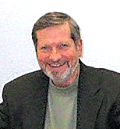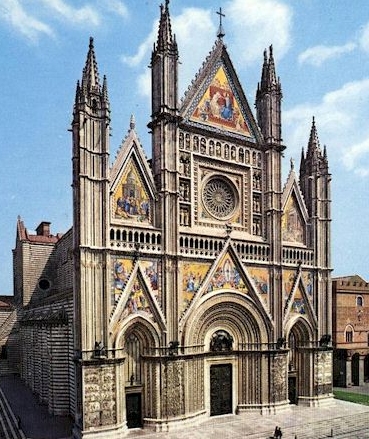 |
Sharing the Experience of the Congregation Sunday, January 27th
<< previous entry ...... next entry > > |
|
|
Dave Schultenover, S.J. is a delegate to the Congregation from the Wisconsin Province, in the US Assistancy. He is a Consultor to the Provincial of the Wisconsin Province and a professor of historical theology at Marquette University. He is the editor in chief of THEOLOGICAL STUDIES, A Jesuit Sponsored Journal of Theology. |
We have completed week one of the second phase of General Congregation 35, the phase called ad negotia (“on to the business”), that is, the business of drafting documents on “matters of greater moment” to provide guidance to Father General Adolfo Nicholás and to the Society of Jesus as we face a new era. Our typical work week runs five and a half days. We get Saturday afternoons and Sundays off. My typical day goes like this: 6:00 AM rise | morning meditation | 7:30 breakfast | check news and any email messages that require immediate response | 9:00 all congregants assemble in the aula for morning prayer | announcements and preview of the day’s schedule | work in small linguistic groups on specific documents | 1:00 pranzo (main meal) | 3:30 return to small groups or assemble in aula for presentations and/or discussions on certain topics | 6:00 end formal business of the day | 6:30 Eucharist in various linguistic groups | social and cena (evening meal). At this point we cannot say which topics for discussion will become formal decrees and which will be referred to the “ordinary governance” of the Society, that is, referred to Father General and his staff and probably ultimately to the assistancies and provincials to deal with regionally. This past week, we were all dispersed part of the time into linguistic groups to work on issues that will most likely become decrees, such as, mission and identity, the vow of obedience (not treated since General Congregation 31), governance (do we need new structures to reflect the changes in how regional assistancies function in relation to the general and the provincials?), cooperation with our lay, religious, and priestly colleagues in ministry. I happened to have been assigned to one of ten small groups that dealt with mission and identity. I ended up being designated secretary of our group of eleven, primarily because I was the only one in the group whose mother tongue was English (still is, by the way). When our moderator asked if anyone would consider volunteering to take notes and write up the results, all eyes turned to me. . . . Fortunately our moderator is a member of the curia staff and has a spacious office with a big-screen projector connected to a laptop computer. So all could see the notes (and my errors) on screen as I recorded them. The technology made note-taking relatively painless, and everyone could easily contribute to the final product. In this group were men from India, Indonesia, Philippines, Korea, Peru, The Netherlands, Rwanda-Burundi, Malta, Colombia, and the USA—an astonishing mix spanning the globe. If the other groups worked the way ours did, there was first substantial sharing about our reactions to reports we had all received from the various assistancies around the world regarding how the rapidly changing world impacts our mission: think of globalization with global economics, instant and ubiquitous electronic communications, growing populations with growing scarcity of resources, violence as a political option, pluralism of religions, gender justice, fundamentalisms etc., etc.; and regarding how various pressures impact our identity as Jesuits: think of, for example, the emphasis coming from Vatican II on the “church of the laity” stemming from increased, and appropriate, emphasis on baptism over against holy orders, and the diminishing number of vocations particularly in the “developed” countries with the leadership of many of our works assumed by the laity. Following this sharing of reactions came a listing of elements that should be included in a possible decree on mission and identity. Our group moderator and I collaborated on the final report. Probably Father General will appoint small groups of about five to write the decrees. After the first drafts are written, they will suffer dissection in the aula by 225 critical minds. Then the writers will have to try to put Humpty-Dumpty back together again, and the fun begins anew, until we pass the final decrees. Meanwhile, there are some dozen or so other topics of concern that will require discussion, first in small linguistic groups, with reports written and submitted to the entire body of congregants for critique. These are topics on which decrees will probably not be produced, but recommendations will be adopted and referred for implementation to the Society’s “ordinary governance.” You might imagine that the work of the congregation is intense, and you would be right. It is intense for several reasons: (1) the issues tend to be very complex, much of the complexity arising from a dizzying array of cultural contexts; (2) the documents will have to try to do justice to all these cultural contexts while being faithful to our common experience of the Spiritual Exercises, Ignatius’s Constitutions and other writings, and documents of recent general congregations; (3) the pressure and desire we feel to get on with the work as expeditiously as possible while not giving any of the issues short shrift; and (4) often enough we have homework to do while we are not actually assembled in small and large groups, so that we have little leisure—except Saturday afternoons and Sundays, when we have time to rest and clear our heads.
There, my mind is now clear! On to week two of ad negotia. . . .
David G. Schultenover, S.J. |
Send Your Sharing About the Congregation
Back to the G.C. 35 Home Page | Creighton U. Online Ministries Home Page
 To
this end, today I joined the men of the East Asian Assistancy who, through
one of their men who works in the curia, rented a 25-seat bus to take
us to Todi and Orvieto, two medieval towns whose foundations date back
to the Etruscan period, ca. 800 years BC. Most stunning of all was the
To
this end, today I joined the men of the East Asian Assistancy who, through
one of their men who works in the curia, rented a 25-seat bus to take
us to Todi and Orvieto, two medieval towns whose foundations date back
to the Etruscan period, ca. 800 years BC. Most stunning of all was the